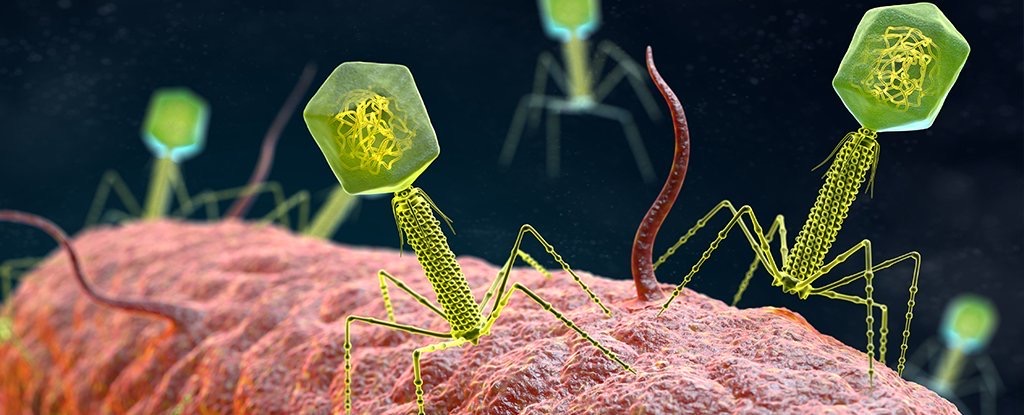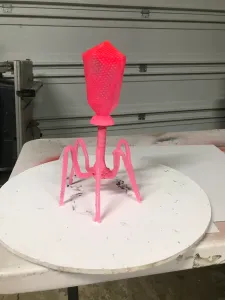
This blog entry journals the sculpting and molding of two different sizes of BACTERIOPHAGE models that will be used in the “Tardigrades in Space” video series.
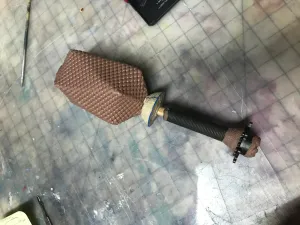
Phages are extremely geometric. In fact, on certain phage species the CAPSULE at the top, which contains the phage’s DNA is a mathematical shape called an ICOSAHEDRON. This is a polygon with 20 faces. I found a template online and modified it in Adobe Illustrator into several different varieties. Some were symmetrical (all 20 faces were triangles of the same size), while others had elongated segments.
For the large model I created an icosahedron with elongated center triangles. For the miniature models I sculpted two: one similar to the large model, the other symmetrical, almost like dice you would use for a game of “Dungeons and Dragons.”
Starting with the large model, I wanted the surface of the capsule to resemble a geometric molecular pattern. So after some searching at Home Depot, I purchased a sheet of textured plastic used as inserts for flourescent ceiling lights.
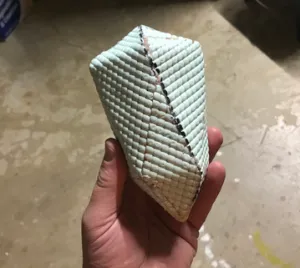
[1] I experimented with pouring melted MONSTER CLAY over the sheet, then cutting and folding it into the icosahedron over a cardboard form. This proved difficult to shape without smooshing it where I didn’t want it to smoosh, so I tried plastic resin, which remains semi-flexible until fully cured to a rigid state
[2] I ended up using this resin version for the silicone capsule mold.
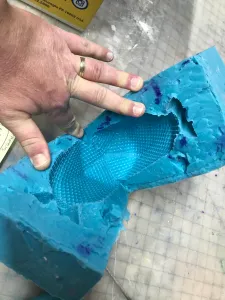
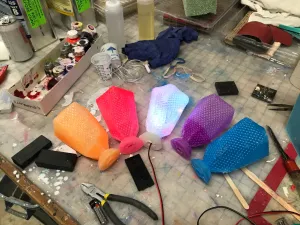
The capsules needed to be hollow to conserve material and allow for interior lighting, so I ROTOCAST by pouring a pigmented semi-clear resin into the silicone mold [3] and rotating it by hand until it set.
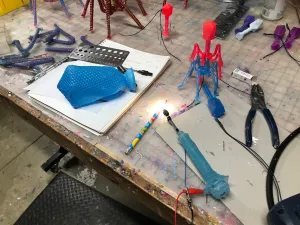
[4] After curing, I drilled a hole in the base as a point of entry for a light bulb as well as the vertical neck, or “sheath” [5], which would be cast as a solid piece in a separate silicone mold.
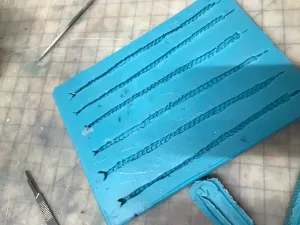
[6] The legs were cast in a third mold as flat units. Prior to pouring I inserted thick wire into the mold.
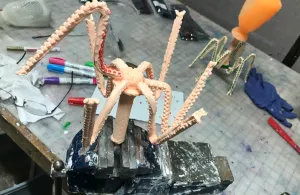
[7] While the resin was still warm and semi-flexible, I bent each of the six legs to the proper shape with pliers; the embedded wire kept the shape while the resin hardened and allows further adjustment for leveling on various surfaces.
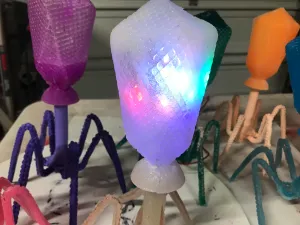
To represent the strand of DNA which is contained in a phage’s capsule, I decided to use lights (besides it adding an awesome visual effect).
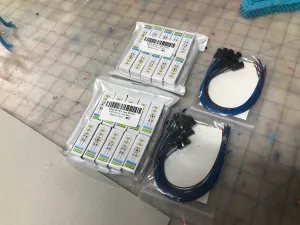
[8] For my first attempt at interior lighting I used 12 volt LEDs, but they weren’t bright enough individually to accomplish the look I was seeking. So I ordered some UNDER-CABINET LEDS and WIRE SOCKETS online [9].
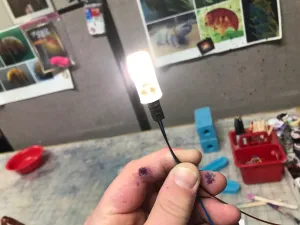
Each bulb is a tiny array of individual diodes facing outward [10].
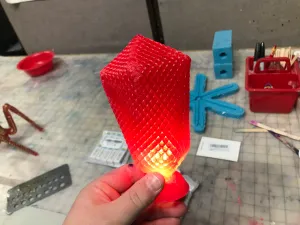
They are meant to replace white-hot halogen bulbs, run off of only 12 volts and generate almost no heat. When put into the hollow resin capsule of a large phage model [11] they produce a wonderful internal glow.
They would make great bedside night lights for children who like science.
PHAGE FIGURINES
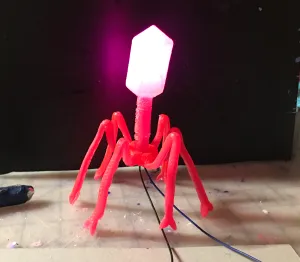
After making about a dozen large models, I decided to sculpt tiny ones. They’re about the same size as the Tardigrade figurines and will fit inside the same plastic clamshells I plan on using to sell figurines on MrAnderson.Rocks along with other merchandise to help fund video production projects.
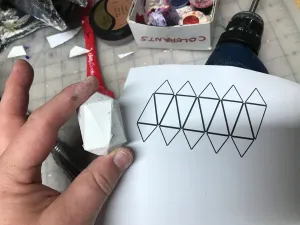
Though these miniatures are cast in solid resin, interior lighting is accomplished by inserting a single LED into a drilled hole. I made these smaller versions so that I could use them in filming scenes where dozens of phages are attacking a bacterial surface. The small figurines are quicker to make and require far less material. Of course, they would also make an awesome string of PATIO LIGHTS!
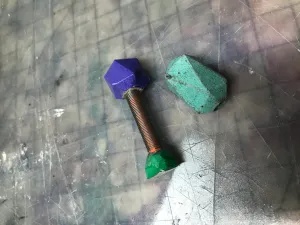
[12] As with the large models, I started by printing out a scaled-down template, glued it to cover stock, and created a hollow form. But rather than wrap clay around the form, I simply poured liquid resin into it, then peeled away the paper to reveal a solid one-off casting.
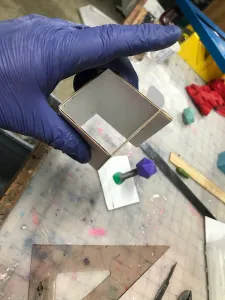

[13] For the neck I slid a spring over a dowel and inserted the unit into a hole drilled in the solid head.
14,15] I hot-glued the head/neck assembly to a baseboard, then built a cardboard box around it. Into this box I poured liquid silicone.
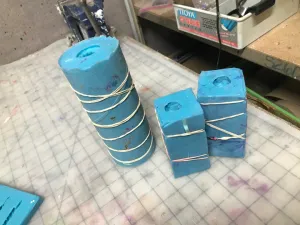
After curing, I cut the resulting cube nearly in half and removed the sculpture. The spot where the neck had been glued down to the baseboard became the pour-hole in the mold for casting plastic resin.
[16] To make each casting, I held the half-severed mold together with rubber bands and filled it with the same clear resin used for the large models. I mixed each tiny batch with a few drops of pigment to create the resulting rainbow of finished units.
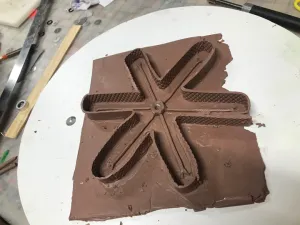
The legs were made in one of two ways. The first was like the large models: wire embedded in liquid resin, then shaped with a pair of pliars while the resin was still warm and flexible.
Unlike the large models whose legs are cast as individuals and glued into the base of the neck afterward, the miniature legs were cast as a single unit in a star-fish shaped mold. I used a hex nut for the shape of the base from which the legs extend.
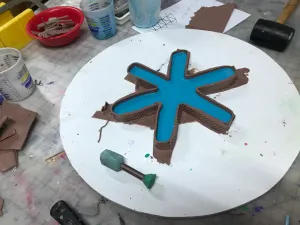
[17] Here you can see the clay sculpture built on a clay base and surrounded with vertical walls.
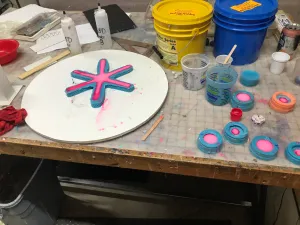
[18] Into this was poured the blue silicone. After curing the clay was removed, the mold flipped over, and then tinted resin poured in.
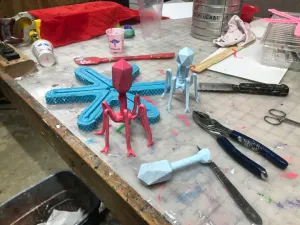
[19] Here you can see pink resin curing in the leg mold as well as several circular “dump molds.” It’s always best to measure out slightly more resin than needed; but rather than dump the extra into the garbage, we dump it into these little molds to create olastic coins or other collectibles.
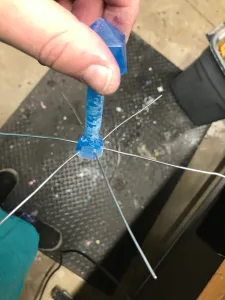
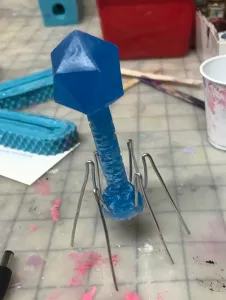
[20] Here are a couple of assembled phage figurines. These happen to be cast in opaque resin, so they won’t contain any lighting.
I also made a number of units using ONLY wire for the legs [21,22], painting them to match the color of each phage body.
Test Video
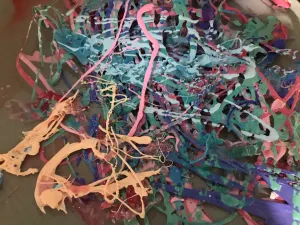
For some test footage of the figurines I threw together a make-shift set meant to resemble the molecular surface of a host bacterium being infected by the parasitic phages.
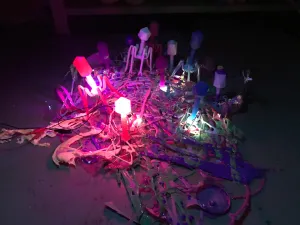
[23] To create my interpretation of the proteins that make up the outer membrane of a bacteria cell I drizzled successive layers of surplus plastic resin onto wax paper instead of pouring it into my dump molds. In reality these structures are too small to photograph even using electron microscopes.
What I know about them I’ve learned from computer graphics based on the current scientific understandings of what these molecular surfaces might look like at atomic scale.
Here is a link to a fantastic animation sequence of this amazing microverse that has inspired and informed so much of what I am creating for Tardigrades In Space:
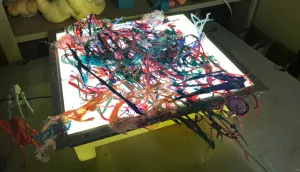
[24] For the first image, I placed this mound of drizzles on the garage floor and photographed it using only the available light emitted by the figurine LEDs.
[25] Keeping with the idea of using inner lighting to represent the “life energy” inside cells and viruses, I placed the drizzle atop a small light table.
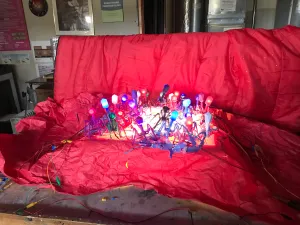
[26] Next, I surrounded the light table with crumpled red butcher paper and used a red sleeping bag for the backdrop.
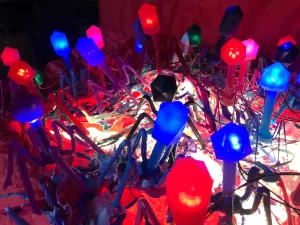
[27] The resulting photos and videos are pretty cool if I do say so myself!
Be sure to check out the next section for some scientific information regarding bacteriophages!
BACTERIOPHAGES
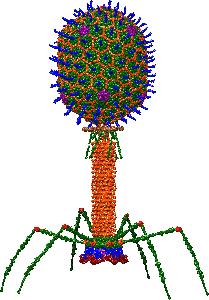
Also known informally as a phage, a bacteriophage is a virus that infects and replicates within bacteria and archaea. The term was derived from “bacteria” and the Greek (phagein), meaning “to devour”.
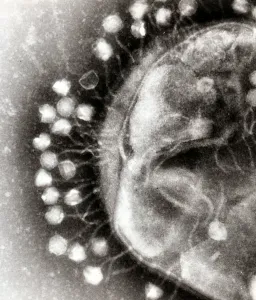
Bacteriophages are composed of proteins that encapsulate a DNA or RNA genome, and may have structures that are either simple or elaborate. Their genomes may encode as few as four genes and as many as hundreds of genes. Phages replicate within the bacterium following the injection of their genome into its cytoplasm.
Bacteriophages are among the most common and diverse entities in the biosphere. Bacteriophages are ubiquitous viruses, found wherever bacteria exist. It is estimated there are more than 1031 bacteriophages on the planet, more than every other organism on Earth, including bacteria, combined. Viruses are the most abundant biological entity in the water column of the world’s oceans, and the second largest component of biomass after prokaryotes, where up to 9×108 virions per millilitre have been found in microbial mats at the surface, and up to 70% of marine bacteria may be infected by phages.
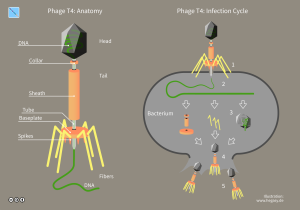
Phages have been used since the late 20th century as an alternative to antibiotics in the former Soviet Union and Central Europe, as well as in France. They are seen as a possible therapy against multi-drug-resistant strains of many bacteria (see phage therapy). On the other hand, phages of Inoviridae have been shown to complicate biofilms involved in pneumonia and cystic fibrosis and to shelter the bacteria from drugs meant to eradicate disease, thus promoting persistent infection.
The full article can be found at: https://en.wikipedia.org/wiki/Bacteriophage

